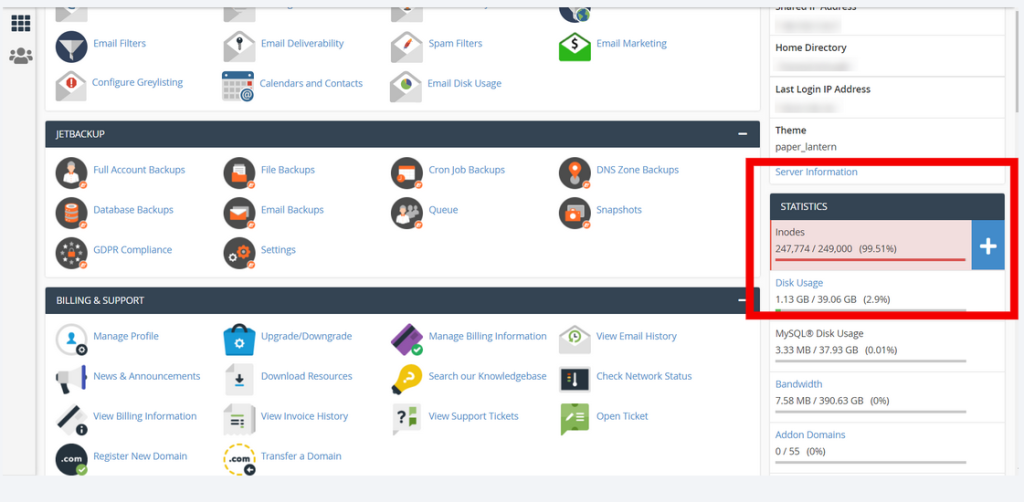Table of Contents
What Is Inode?
It is a record in a disk table, which contains information about a file or folder such as its size, owner, device node, socket, pipe, etc., except data content and file name. The number of inodes on your account equals the number of files and folders you have on it.
Every time a file is opened, the file’s is read by the kernel of the server. The more files/folders you have, the more inodes you use. And the more inodes you use, the more system resources your account consumes. That is why it is a common and necessary practice among hosts to limit the number of inodes on a shared server, where it is not suitable for one account to use system resources and leave no power for the other accounts.
View Inode Usage
If you are on cPanel, you can view your usage by logging in to your cPanel then check the right and check on the right navigation as per the image below.

If you are on Direct Admin
You can log in your Direct Admin on https://yourdomain.com:2222 then checking on the right

Decreasing Inode Usage
Most people will not need to be familiar with it, if they are using their hosting in normal circumstances such as for a basic or intermediate website and normal email use. However, to ensure that all our customers get a consistently high level of service we have implemented inode limits per account for reducing resource abusers in our Shared Hosting and Reseller hosting. In our VPS Hosting this concept is overcomed.
Not all overages are caused by abuse though. It could just be that you need to do a bit of a clean up of your hosting files. If you experience issues caused by high usage then this tutorial is to help you decrease the number of inodes on your account.
Here are some steps to reduce the limit.
1) Delete Unnecessary Files And Folders
Examine the files and folders manually and decide on if the file is necessary or not. In case if the file is an old backup archive or if the folder is created for testing or staging purpose, you may remove it or download it locally via FTP or cPanel >> FileManager and delete it from the server.
2) Clear Old And Spam Emails
Deleting the old emails helps a lot in decreasing the usage. There might be spam mails in your mailbox which are of no use and deleting those mails will hep you to reduce the inode number. You can remove spam emails from email client or webmail. You can seek help from our support department which operates 24*7 to delete the mails easily via shell.
3) Clear The Cache Files
Most of the CMSs uses cache to reduce the response time and application like Joomla / WordPress can create a lot of cache files which can increase the inode usage tremendously. So it is advised to keep an eye on the cache folders and make sure the number of cache files is the least.
Most of the CMSs now provide the facility to purge the cache and you can make use of it to control the number of cache files. Or you can setup a cronjob to automatically clear the cache files periodically.
If you have the inode limit getting hit regularly or you still have issues after you have cleared up your files, we suggest you to upgrade the package to a higher one with higher inode limit or consider a Virtual Private Server. You can contact our 24/7 support for this.
3) Clear the Obsolete Cache (.opcache) System Folder
You can uninstall the .opcache system folder in your account using FTP. If you use PHP 7.x, this is where obsolete caches are stored.
As you use the program, the cache will be restored but won’t overwrite cached files from older PHP accounts.

